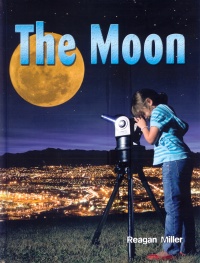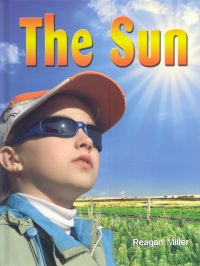| ________________
CM . . .
. Volume XVIII Number 40. . . .June 15, 2012

 |
The Moon. (Journey Through Space).
Reagan Miller.
St. Catharines, ON: Crabtree, 2012.
24 pp., pbk. & hc., $7.95 (pbk.), $18.36 (RLB.).
ISBN 978-0-7787-5311-7 (pbk.), ISBN 978-0-7787-5306-3 (RLB).
Subject Heading:
Moon-Juvenile literature.
Grades 2-3 / Ages 7-8.
Review by Gail Hamilton.
**½ /4
|
| |
|
 |
The Planets. (Journey Through Space).
Chelsea Donaldson.
St. Catharines, ON: Crabtree, 2012.
24 pp., pbk. & hc., $7.95 (pbk.), $18.36 (RLB.).
ISBN 978-0-7787-5312-4 (pbk.), ISBN 978-0-7787-5307-0 (RLB).
Subject Heading:
Planets-Juvenile literature.
Grades 2-3 / Ages 7-8.
Review by Gail Hamilton.
** /4
|
| |
|
 |
The Sun. (Journey Through Space).
Reagan Miller.
St. Catharines, ON: Crabtree, 2012.
24 pp., pbk. & hc., $7.95 (pbk.), $18.36 (RLB.).
ISBN 978-0-7787-5314-8 (pbk.), ISBN 978-0-7787-5309-4 (RLB).
Subject Heading:
Sun-Juvenile literature.
Grades 2-3 / Ages 7-8.
Review by Gail Hamilton.
**½ /4
|
| |
|
 |
The Stars. (Journey Through Space).
Jeff Wimbush.
St. Catharines, ON: Crabtree, 2012.
24 pp., pbk. & hc., $7.95 (pbk.), $18.36 (RLB.).
ISBN 978-0-7787-5313-1 (pbk.), ISBN 978-0-7787-5308-7 (RLB).
Subject Heading:
Stars-Juvenile literature.
Grades 2-3 / Ages 7-8.
Review by Gail Hamilton.
**½ /4
|
| |
|

excerpt:
The moon and planets are always moving! The planets orbit the Sun. The Moon orbits Earth. It takes about 28 days for the Moon to orbit, or travel once around Earth.
The Moon also rotates, or spins, as it orbits Earth. The Moon rotates on its axis. The axis is an imaginary line through the middle of the Moon from its top to its bottom. It takes the Moon 28 days to make one complete rotation on its axis. It takes the Moon about the same amount of time to orbit once around Earth. This means that the same side of the Moon always faces Earth. (From The Moon.)
Four titles comprise the new “Journey through Space” series which serves as a basic introduction to the main components of the solar system. The majority of the books have nine chapters as well as a table of contents, a glossary, an index and list of kid-friendly websites for further exploration. Many of the websites are interactive, providing activities, games, lessons and images.
Occasionally, some of the information is repeated in other volumes, for example, an explanation of gravitational force, orbits, rotation and revolution, and the types of stars. This is not problematic as each book is a stand-alone. The text, most of which is quite easy for young readers to comprehend, is printed in a large, simple font. Diagrams and wonderful colour photographs enhance the text. There are one or two activities per volume that relate to the concepts in the text. These activities require easily obtained materials, such as a flashlight, a styrofoam ball or a mirror, but most require the assistance of a friend or two.
There are a few minor flaws in the books: firstly, a spelling error and the capitalization of the words “sun” and “moon” when they needn’t be capitalized; secondly, there is a graph in the volume about stars which can be somewhat confusing to young readers; and, in the book about the planets, a diagram showing the orbit paths of the various planets is not drawn in proper proportion or scale. For example, it shows Earth and Uranus to be larger than Saturn, and Neptune to be the same size as Saturn.
The Moon highlights Earth’s closest space neighbour. Readers will first learn that a moon is an object that orbits around a planet and that moons can be different shapes and sizes and have different patterns. Earth’s moon, which is covered with craters and plains, is the fifth largest in the solar system. Hot by day and cold by night, the moon cannot support life as it has no air and no liquid water. This title discusses the length of the moon’s orbit, its rotation on its axis, and its eight phases. Readers are shown the size of the moon relative to the size of Earth by means of a diagram; another diagram shows the eight moon phases. The activity included in this title will help readers to understand that the moon reflects the sun’s light. Students are also encouraged to keep a “moon diary” for 28 days and to draw a picture of what the moon looks like on each of those days. Lunar eclipses and the first moon landing on July 20, 1969, are other topics.
The Planets begins with a definition of a planet, followed by an explanation of how planets travel in an orbit. The featured activity, requiring a styrofoam ball, a needle and thread, and a lamp, will demonstrate rotation and revolution. A double-page spread is devoted to each of the eight planets in the solar system. Information about each planet is, obviously, very limited, but includes size, temperature, orbit length and any special or interesting characteristics of the planet. For instance, Venus has volcanoes that are 100 times larger than volcanoes on Earth; both Venus and Uranus rotate in the opposite direction to Earth’s rotation; and, Jupiter, Saturn, Uranus and Neptune are planets made up of gases. Students might be surprised to learn that, if they were able to step on one of these planets, their foot would go right through (a difficult concept for youngsters to grasp). A comparison chart provides information about each planet’s width, and the length of its day and year.
Light-years, hot and cold stars, galaxies and constellations are just a few of the topics covered in The Stars. This title will explain the various colours of stars (the hottest being blue and the coldest being red), how stars are formed in clouds of dust and gas called nebulas, and how stars die out, burning up in a supernova. A slight contradiction in this book is that, in one paragraph, the author states that stars do not move, Earth does, yet on the same page, in another paragraph, he states, “Stars also move through space. They are so far away, however, it is difficult to see them move.” On the following page, there is an activity which requires readers to trace the movement of a star by using a landmark as a point of reference. So, readers will undoubtedly ask, do stars move or not? And, if it so difficult to see stars move, then why attempt the activity? Adults, of course, know the answer to these questions, but children might be a bit confused. Finally, the book ends with some information about stargazing and explains the difference between meteors (also known as shooting stars), comets and satellites.
The sun is not only a yellow dwarf star, which means that it is medium-sized, but it is also considered a medium-bright star. Its proximity to Earth, however, makes it appear to be extremely hot and bright in comparison to other stars. The Sun features information about the sun’s layers, sunspots, solar flares, solar eclipses, its distance from earth, and its many benefits to humans. Night and day are caused by the Earth’s rotation, whereas the seasons are caused by its revolution. Readers will also learn that sunrise and sunset are deceptive because they are not actually the result of the sun’s movement, but of the Earth’s. Several diagrams are included in this title and help to show the orbit of the planets around the sun, the position of Earth during the four seasons, and the positions of the sun, moon and Earth during a solar eclipse.
Generally, the series is limited as to the amount of information it imparts, but it just might pique the curiosity of young, budding astronomers.
Recommended.
Gail Hamilton is a former teacher-librarian in Winnipeg, MB.

To comment
on this title or this review, send mail to cm@umanitoba.ca.
Copyright © the Manitoba Library Association. Reproduction for personal
use is permitted only if this copyright notice is maintained. Any
other reproduction is prohibited without permission.
NEXT REVIEW | TABLE OF CONTENTS FOR THIS ISSUE
- June 15, 2012.
AUTHORS | TITLES | MEDIA REVIEWS | PROFILES | BACK ISSUES | SEARCH | CMARCHIVE | HOME
|



